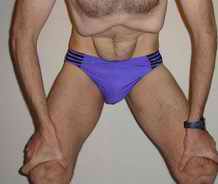
Lotus position or Padmasana is a cross-legged sitting meditation pose from ancient India, in which each foot is placed on the opposite thigh. It is an ancient asana in yoga, predating hatha yoga, and is widely used for meditation in Hindu, Tantra, Jain, and Buddhist traditions.
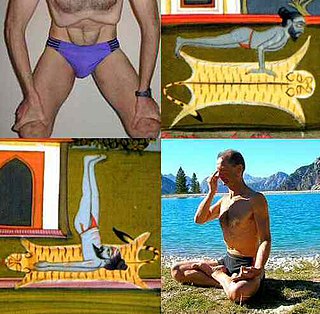
Hatha yoga is a branch of yoga that uses physical techniques to try to preserve and channel vital force or energy. The Sanskrit word हठ haṭha literally means "force", alluding to a system of physical techniques. Some hatha yoga style techniques can be traced back at least to the 1st-century CE, in texts such as the Hindu Sanskrit epics and Buddhism's Pali canon. The oldest dated text so far found to describe hatha yoga, the 11th-century Amṛtasiddhi, comes from a tantric Buddhist milieu. The oldest texts to use the terminology of hatha are also Vajrayana Buddhist. Hindu hatha yoga texts appear from the 11th century onward.
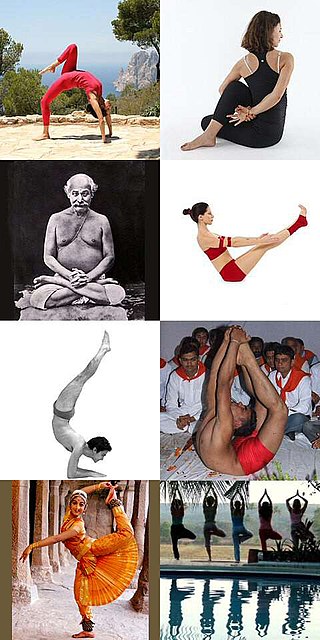
An āsana is a body posture, originally and still a general term for a sitting meditation pose, and later extended in hatha yoga and modern yoga as exercise, to any type of position, adding reclining, standing, inverted, twisting, and balancing poses. The Yoga Sutras of Patanjali define "asana" as "[a position that] is steady and comfortable". Patanjali mentions the ability to sit for extended periods as one of the eight limbs of his system. Asanas are also called yoga poses or yoga postures in English.
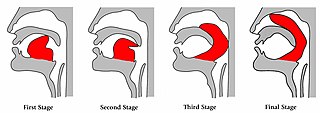
Khecarī mudrā is a hatha yoga practice carried out by curling the tip of the tongue back into the mouth until it reaches above the soft palate and into the nasal cavity. The tongue is made long enough to do this with many months of daily tongue stretching and, in some versions of the practice, by gradually severing the lingual frenulum with a sharp implement over a period of months.

Downward Dog Pose or Downward-facing Dog Pose, also called Adho Mukha Svanasana, is an inversion asana, often practised as part of a flowing sequence of poses, especially Surya Namaskar, the Salute to the Sun. The asana is commonly used in modern yoga as exercise. The asana does not have formally named variations, but several playful variants are used to assist beginning practitioners to become comfortable in the pose.
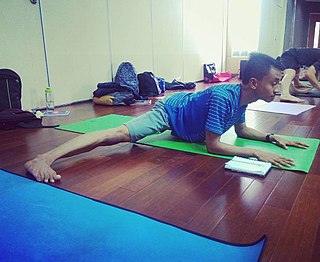
Yoga as therapy is the use of yoga as exercise, consisting mainly of postures called asanas, as a gentle form of exercise and relaxation applied specifically with the intention of improving health. This form of yoga is widely practised in classes, and may involve meditation, imagery, breath work (pranayama) and calming music as well as postural yoga.

The shatkarmas, also known as shatkriyas, are a set of Hatha yoga purifications of the body, to prepare for the main work of yoga towards moksha (liberation). These practices, outlined by Svatmarama in the Haṭha Yoga Pradīpikā as kriya, are Netī, Dhautī, Naulī, Basti, Kapālabhātī, and Trāṭaka. The Haṭha Ratnavali mentions two additional purifications, Cakri and Gajakarani, criticising the Hatha Yoga Pradipika for only describing the other six.

Kumbhaka is the retention of the breath in the yoga practice of pranayama. It has two types, accompanied whether after inhalation or after exhalation, and, the ultimate aim, unaccompanied. That state is kevala kumbhaka, the complete suspension of the breath for as long as the practitioner wishes.

Dhauti is one of the Shatkarmas, which form the yogic system of body cleansing techniques. It is intended mainly to the cleaning of the digestive tract in its full length but it affects also the respiratory tract, external ears and eyes.

Basti is an important shatkarma, a yogic purification, intended to clean the lower abdomen, especially the colon. The Hatha Yoga Pradipika and other sources attribute to it many beneficial effects. There are two ways to perform Basti:

Garbha Pindasana, Embryo in Womb Pose, sometimes shortened to Garbhasana, is a seated balancing asana in hatha yoga and modern yoga as exercise.

A bandha is a kriyā in Hatha Yoga, being a kind of internal mudra described as a "body lock," to lock the vital energy into the body. Bandha literally means bond, fetter, or "catching hold of".
Forrest Yoga is a style of yoga as exercise. It was created by and named for Ana T. Forrest in 1982. It is known for "its long holding of positions, emphasis on abdominal core work, and standing series that can go on for 20 poses on each side". Reputed for its intensity, the style emphasizes connecting to one's feelings in order to work through physical and emotional trauma.
Modern yoga is a wide range of yoga practices with differing purposes, encompassing in its various forms yoga philosophy derived from the Vedas, physical postures derived from Hatha yoga, devotional and tantra-based practices, and Hindu nation-building approaches.

Yoga as exercise is a physical activity consisting mainly of postures, often connected by flowing sequences, sometimes accompanied by breathing exercises, and frequently ending with relaxation lying down or meditation. Yoga in this form has become familiar across the world, especially in the US and Europe. It is derived from medieval Haṭha yoga, which made use of similar postures, but it is generally simply called "yoga". Academics have given yoga as exercise a variety of names, including modern postural yoga and transnational anglophone yoga.
Mark Singleton is a scholar and practitioner of yoga. He studied yoga intensively in India, and became a qualified yoga teacher, until returning to England to study divinity and research the origins of modern postural yoga. His doctoral dissertation, which argued that posture-based forms of yoga represent a radical break from haṭha yoga tradition, with different goals, and an unprecedented emphasis on āsanas, was later published in book form as the widely-read Yoga Body.

Hatha Yoga: The Report of a Personal Experience is a 1943 book by Theos Casimir Bernard describing what he learnt of hatha yoga, ostensibly in India. It is one of the first books in English to describe and illustrate a substantial number of yoga poses (asanas); it describes the yoga purifications (shatkarmas), yoga breathing (pranayama), yogic seals (mudras), and meditative union (samadhi) at a comparable level of detail.
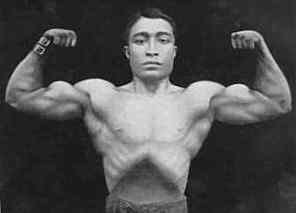
Bishnu Charan Ghosh was an Indian bodybuilder and Hathayogi. He was the younger brother of yogi Paramahansa Yogananda, who wrote the 1946 book Autobiography of a Yogi. In 1923, he founded the College of Physical Education, Calcutta. His writings influenced the development of modern yoga as exercise in India and Bikram Choudhury founded Bikram Yoga based on his teachings.

The science of yoga is the scientific basis of modern yoga as physical exercise in human sciences such as anatomy, physiology, and psychology. Yoga's effects are to some extent shared with other forms of exercise, though it differs in the amount of stretching involved, and because of its frequent use of long holds and relaxation, in its ability to reduce stress. Yoga is here treated separately from meditation, which has effects of its own, though yoga and meditation are combined in some schools of yoga.

Postural yoga began in India as a variant of traditional yoga, which was a mainly meditational practice; it has spread across the world and returned to the Indian subcontinent in different forms. The ancient Yoga Sutras of Patanjali mention yoga postures, asanas, only briefly, as meditation seats. Medieval Haṭha yoga made use of a small number of asanas alongside other techniques such as pranayama, shatkarmas, and mudras, but it was despised and almost extinct by the start of the 20th century. At that time, the revival of postural yoga was at first driven by Indian nationalism. Advocates such as Yogendra and Kuvalayananda made yoga acceptable in the 1920s, treating it as a medical subject. From the 1930s, the "father of modern yoga" Krishnamacharya developed a vigorous postural yoga, influenced by gymnastics, with transitions (vinyasas) that allowed one pose to flow into the next.
